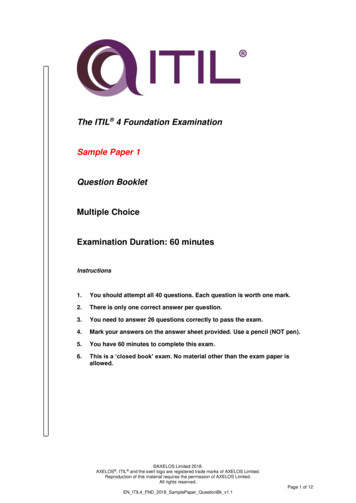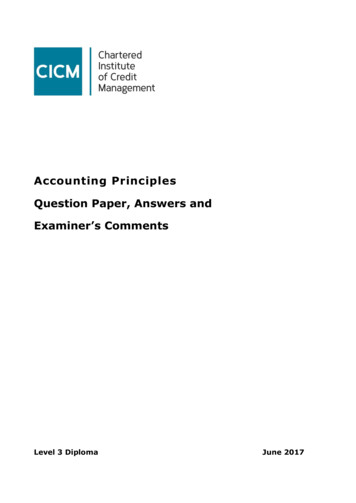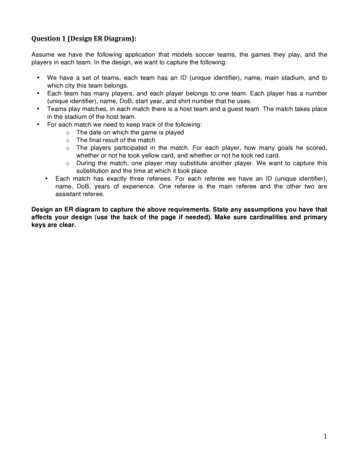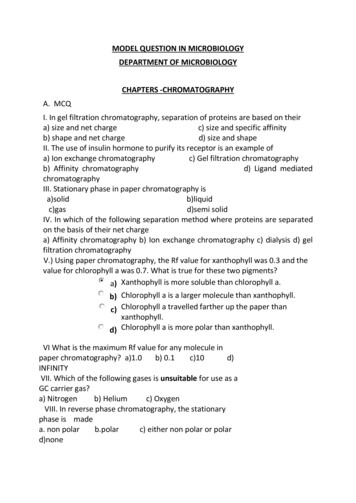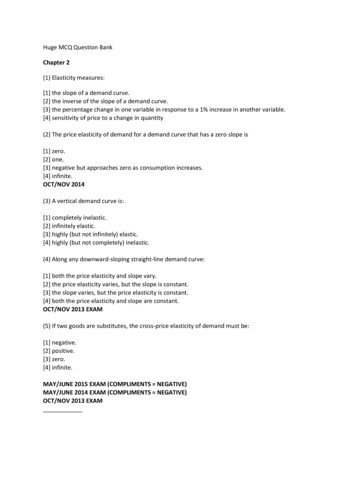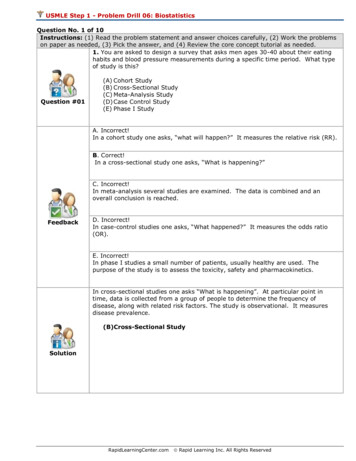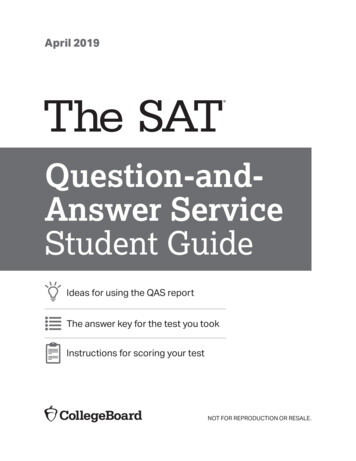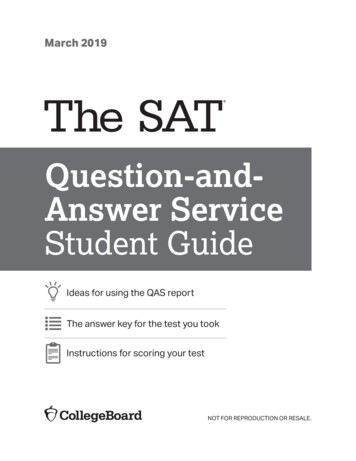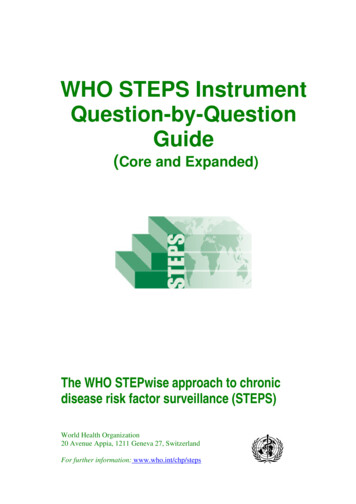
Transcription
WHO STEPS InstrumentQuestion-by-QuestionGuide(Core and Expanded)The WHO STEPwise approach to chronicdisease risk factor surveillance (STEPS)World Health Organization20 Avenue Appia, 1211 Geneva 27, SwitzerlandFor further information: www.who.int/chp/steps
STEPS Question-by-Question (Q-by-Q)GuideOverviewIntroductionThe Question-by-Question Guide presents the STEPS Instrument with a briefexplanation for each of the questions.PurposeThe purpose of the Question-by-Question Guide is to provide backgroundinformation to the interviewers and supervisors as to what is intended by eachquestion.Interviewers can use this information when participants request clarificationabout specific questions or they do not know the answer.Interviewers and supervisors should refrain from offering their owninterpretations.Guide to thecolumnsColumnNumberQuestionResponseCodeThe table below is a brief guide to each of the columns in the Q-by-Q Guide.DescriptionThis question reference number is designedto help interviewers find their place ifinterrupted.The question text to be read to theparticipants followed by questioninstructions.This column lists the available responseoptions which the interviewer will be circlingor filling in the text boxes. The skipinstructions are shown on the right hand sideof the responses and should be carefullyfollowed during interviews.The column is designed to match data fromthe Instrument into the data entry tool, dataanalysis syntax, data book, and fact sheet.Site TailoringRenumber the instrumentsequentially once the contenthas been finalized Select sections to use. Add expanded and optionalquestions as desired. Add site specific responsesfor demographic responses(e.g. C6). Change skip questionidentifiers from code toquestion number.This should never be changedor removed. The code is usedas a general identifier for thedata entry and analysis.
Participant Identification NumberSTEPS Q-by-Q Guidefor Chronic Disease Risk Factor Surveillance insert country/site name Survey InformationLocation and Date12ResponseCodeCluster/Centre/Village ID Record Cluster, Centre or Village ID from list providedI1Cluster/Centre/Village nameI2Insert Cluster, Centre or Village name as appropriateInterviewer ID34 I3 ddmmyearI4Record interviewer's identificationDate of completion of the instrumentRecord date when instrument actually completed For further guidance on obtaining consent, see Part 4, Section 1, Page 4-1-11.Participant Id Number Consent, Interview Language and Name567ResponseYes1No2English[Add others][Add others][Add others]1234Consent has been read and obtainedCircle relevant response.Interview Language [Insert Language]Circle relevant response.Time of interview(24 hour clock)Record time interview started.Family Surname89Write family surname (reassure the participant on the confidentialnature of this information and that this is only needed for follow up).First NameWrite first name of respondent.CodeI5If NO, ENDI6 : hrsI7minsI8I9Additional Information that may be helpful10Contact phone number where possibleRecord phone number.I10Record and file identification information (I5 to I10) separately from the completed questionnaire.WHO STEPwise approach to chronic disease risk factor surveillance- Instrument v2.15-2-1
Participant Identification NumberStep 1Demographic InformationFor further guidance on completing demographic information, see Part 3, Section 2.CORE: Demographic InformationQuestion11121314ResponseSex (Record Male / Female as observed)Circle Male / Female as observed.What is your date of birth?Don't Know 77 77 7777Record date of birth of participant.How old are you?Help participant estimate their age by interviewingthem about their recollection of widely known majorevents.In total, how many years have you spent at school orin full-time study (excluding pre-school)?Record total number of years of education (excludingpre-school and kindergarten).MaleFemale12 If known, Go to C4ddmmyearCodeC1C2C3Years C4Years EXPANDED: Demographic Information15What is the highest level of education you havecompleted?[INSERT COUNTRY-SPECIFIC CATEGORIES]If a person attended a few months of the first year ofsecondary school but did not complete the year, record“primary school completed”. If a person only attendeda few years of primary school, record “less thanprimary school”.Circle appropriate response.No formal schooling1Less than primary school2Primary school completed3Secondary school completed4High school completed5College/University completed6Post graduate degree7Refused16What is your [insert relevant ethnic group / racial group /cultural subgroup / others] background?Circle the relevant ethnic/cultural group to which theparticipant belongs.What is your marital status?17Circle the appropriate response.12[Locally ng619How many people older than 18 years, includingyourself, live in your household?Record the total number of people living in thehousehold who are 18 years or etired7Unemployed (able to work)8Unemployed (unable to work)9C888C9Number of peopleWHO STEPwise approach to chronic disease risk factor surveillance- Instrument v2.1C788Government employeeNon-government employeeRefusedC688Never marriedCurrently marriedRefusedWhich of the following best describes your main workstatus over the past 12 months?[INSERT COUNTRY-SPECIFIC CATEGORIES](USE SHOWCARD)The purpose of this question is to help answer otherquestions such as whether or not health statuscontributes to unemployment, or whether people indifferent kinds of occupations may be confronted withdifferent risk factors.Circle appropriate response.88[Locally defined][Locally defined]RefusedC5 5-2-2
Participant Identification NumberEXPANDED: Demographic Information, ContinuedQuestion2021CodeResponseTaking the past year, can you tell me what theaverage earnings of the household have been?(RECORD ONLY ONE, NOT ALL 3)Record the average earnings of the household byweek, month, or year. If refused to answer, skip toC11.Per week Go to T1OR per month Go to T1C10aC10bOR per year Go to T1C10c88C10dRefusedIf you don’t know the amount, can you give anestimate of the annual household income if I readsome options to you? Is it[INSERT QUINTILE VALUES IN LOCAL CURRENCY] Quintile (Q) 11More than Q 1, Q 22More than Q 2, Q 33More than Q 3, Q 44More than Q 45(READ OPTIONS)Circle the quintile value which is the closest to theannual household income.Step 1Don't Know77Refused88C11Behavioural MeasurementsFor further guidance on completing Behavioural Measurements, see Part 3, Section 2.CORE: Tobacco UseNow I am going to ask you some questions about various health behaviours. This includes things like smoking, drinking alcohol, eating fruitsand vegetables and physical activity. Let's start with tobacco.Question22232425ResponseDo you currently smoke any tobacco products, suchas cigarettes, cigars or pipes? (USE SHOWCARD)Ask the participant to think of any tobacco productshe/she is smoking currently.Do you currently smoke tobacco products daily?This question is only for current smokers of tobaccoproducts.How old were you when you first started smokingdaily?For current daily smokers only. Ask the participant tothink of the time when he/she started to smoke anytobacco products daily.Do you remember how long ago it was?(RECORD ONLY 1, NOT ALL 3)1No2Yes1No2Don’t know 77 If known, go to T5aIn Years If known, go to T5aORin Months If known, go to T5aORin Weeks Manufactured cigarettes T5aHand-rolled cigarettes T5bPipes full of tobacco T5cCigars, cheroots, cigarillos T5dDon’t know 77For current daily smokers only.Specify zero if no products were used in each categoryinstead of leaving categories blank. Then go to T9 .Daily smokers don't have to answer questions on pastsmoking T6-T8c.T2If No, go to T6T3(RECORD FOR EACH TYPE)26T1If No, go to T6Age (years)Don’t know 77If the participant doesn’t remember his/her age whenstarted smoking, then record the time in years, monthsor weeks as appropriate.On average, how many of the following do you smokeeach day?YesCodeOtherOther (please specify):WHO STEPwise approach to chronic disease risk factor surveillance- Instrument v2.1T4aT4bT4cIf Other, go to T5other, else go to T9 T5eT5otherGo to T95-2-3
Participant Identification NumberEXPANDED: Tobacco UseQuestion2728In the past, did you ever smoke daily?Ask the participant to think of the time when he/shemay have been smoking tobacco products on a dailybasis.How old were you when you stopped smoking daily?Ask the participant to think of the time when he/shestopped smoking tobacco products on a daily basis.Yes3031Don’t know 77If the participant doesn't remember his/her age whenthey started smoking, then record the time in weeks,months or years as appropriate.Don’t Know 77 If Known, go to T9T7In Years If Known, go to T9T8ain Months If Known, go to T9T8bin Weeks T8cORORDo you currently use any smokeless tobacco suchas [snuff, chewing tobacco, betel]?(USE SHOWCARD)Ask the participant to think of any smokeless tobaccoproducts the he/she is using currently.Yes1No2Yes1No2T9Do you currently use smokeless tobacco productsdaily?For current users of smokeless tobacco products only.Snuff, by nose Chewing tobacco Betel, quid For daily users of smokeless tobacco products only.Record for each type of smokeless tobacco products.Record zero if no products were used in each categoryinstead of leaving categories blank. Then go to T13 .Daily users of smokeless tobacco don't have to answerthe question on past use T12.OtherOther (specify)35In the past, did you ever use smokeless tobacco suchas [snuff, chewing tobacco, or betel] daily?Ask the participant to think of the time when he/shemay have been using smokeless tobacco products on adaily basis.YesT11aT11bT11cT11dIf Other, go to T11 other, else go to T13 Go to T13T11eT11other1T12NoDuring the past 7 days, on how many days didsomeone in your home smoke when you werepresent?Record the number of days.During the past 7 days, on how many days didsomeone smoke in closed areas in your workplace (inthe building, in a work area or a specific office) whenyou were present?Record the number of days. For those not working in aclosed area, record 77.T10If No, go to T12 Don't Know 7734If No, go to T12Snuff, by mouth(RECORD FOR EACH TYPE, USE SHOWCARD)332 If No, go to T9Age (years)On average, how many times a day do you use .321T6NoDo you remember how long ago it was?(RECORD ONLY 1, NOT ALL 3)29CodeResponse2Number of daysT13Don't know 77 Number of daysT14Don't know or don'twork in a closed area 77WHO STEPwise approach to chronic disease risk factor surveillance- Instrument v2.1 5-2-4
Participant Identification NumberCORE: Alcohol ConsumptionThe next questions ask about the consumption of alcohol.Question3637383940414243ResponseHave you ever consumed an alcoholic drink such asbeer, wine, spirits, fermented cider or [add other localexamples] )?(USE SHOWCARD OR SHOW EXAMPLES)Think of any drinks that contain alcohol.Yes1A1aNoHave you consumed an alcoholic drink within the past12 months?Think of any drinks that contain alcohol.During the past 12 months, how frequently have youhad at least one alcoholic drink?(READ RESPONSES, USE SHOWCARD)Think of the past year only.CodeYesNo2 If No, go to D11Daily15-6 days per week21-4 days per week31-3 days per month4Less than once a month5Yes1Have you consumed an alcoholic drink within the past30 days?Circle the appropriate response.During the past 30 days, on how many occasions didyou have at least one alcoholic drink?Think of the past 30 days only. Record the number ofoccasions. Note that there can be more than oneoccasion in which alcohol is consumed in a given day.During the past 30 days, when you drank alcohol, onaverage, how many standard alcoholic drinks didyou have during one drinking occasion?(USE SHOWCARD)Help the respondent by averaging out the total numberof drinks.During the past 30 days, what was the largest numberof standard alcoholic drinks you had on a singleoccasion, counting all types of alcoholic drinkstogether?Think of the past 30 days only.During the past 30 days, how many times did you havefor men: five or morefor women: four or morestandard alcoholic drinks in a single drinking occasion?Think of the past 30 days only. Be sure to read thecorrect number of times: 5 or more for MEN, 4 or morefor WOMEN.WHO STEPwise approach to chronic disease risk factor surveillance- Instrument v2.1A1b2 If No, go to D1A2A3No2 If No, go to D1NumberDon’t know 77A4 NumberDon’t know 77A5 Largest numberDon't Know 77A6 Number of timesDon't Know 77A7 5-2-5
Participant Identification NumberEXPANDED: Alcohol Consumption44During the past 30 days, when you consumed analcoholic drink, how often was it with meals? Please donot count snacks.Think of the past 30 days only.Usually with mealsSometimes with mealsRarely with mealsNever with mealsDuring each of the past 7 days, how many standarddrinks of any alcoholic drink did you have each day?(USE SHOWCARD)Don't know 7745Think of the past week only.A “standard drink” is the amount of ethanol contained instandard glasses of beer, wine, fortified wine such assherry, and spirits.Depending on the country, these amounts will varybetween 8 and 13 grams of ethanol. See showcard.Record for each day the number of standard drinks. Ifno drinks record 0.WHO STEPwise approach to chronic disease risk factor surveillance- Instrument v2.11234A8Monday A9aTuesday A9bWednesday A9cThursday A9dFriday A9eSaturday A9fSunday A9g5-2-6
STEPS Question-by-Question (Q-by-Q) Guide Overview Introduction The Question-by-Question Guide presents the STEPS Instrument with a brief explanation for each of the questions. Purpose The purpose of the Question-by-Question Guide is to provide background information to the interviewers and supervisors as to what is intended by each question.
